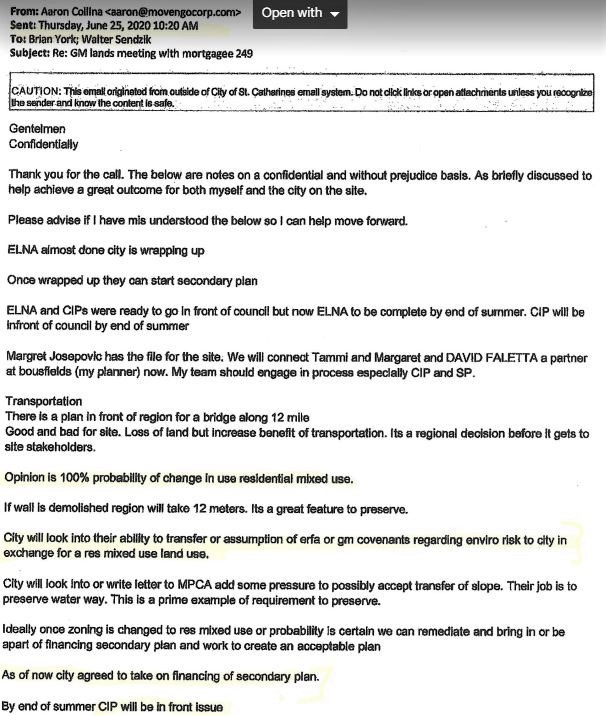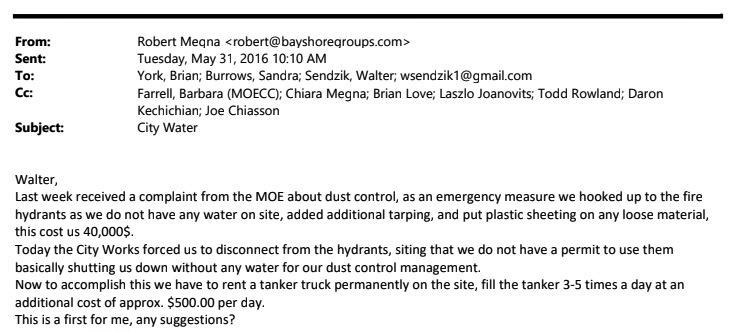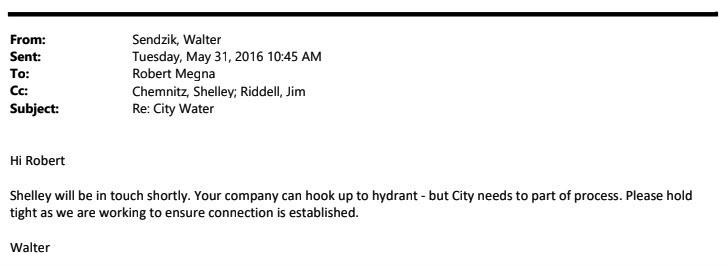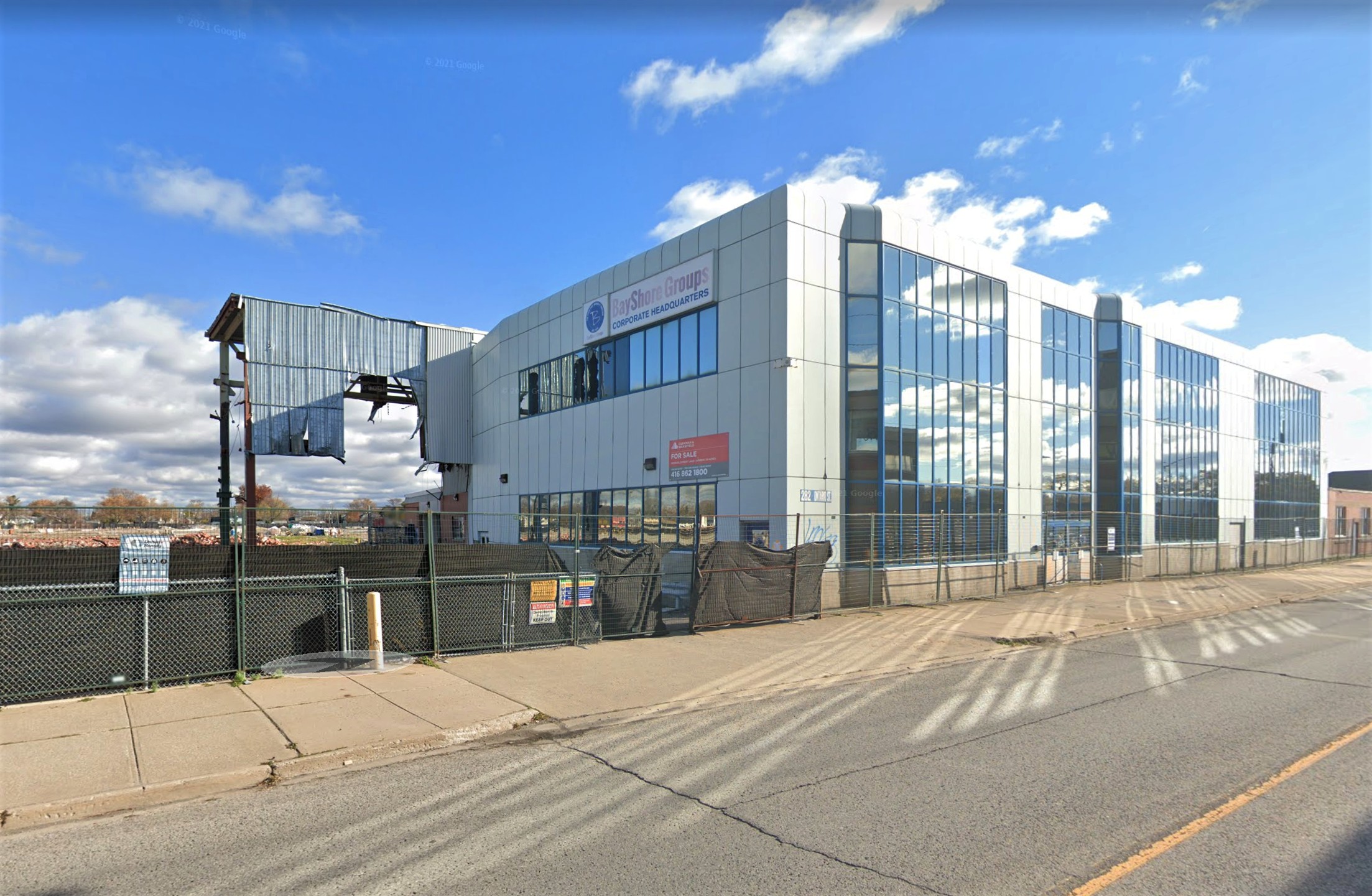
FOI documents reveal backroom dealings between St. Catharines mayor, developer to build homes on contaminated GM lands despite public safety concerns
St. Catharines Mayor Walter Sendzik had private conversations with a developer and the City’s head of economic development two years ago to push a mixed-use residential project on the contaminated former GM lands, before the extent of the risks to public health were known.
The president of Movengo Corp., Aaron Collina, emailed Sendzik and Brian York, St. Catharines’ director of economic development, on June 25, 2020. Movengo, a Hamilton-based developer, is the lender that provided financing to the original developer, Bayshore, which bought the property from GM in 2014. Movengo now appears to be advancing the project.
“Gentlemen Confidentially Thank you for the call,” Collina wrote, detailing what was discussed between the three men. A copy of the email was one of the FOI documents obtained by The Pointer that show Sendzik and senior staff working behind the scenes with the developer while members of the public who raised health concerns over the contaminated site were assured by the City that steps were being taken to protect residents.
Collina wrote, according to his account of the conversation with the mayor and head of economic development, the City would “pressure” the Niagara Peninsula Conservation Authority to acquire a part of the GM land where contamination was likely being sent into 12 Mile Creek, which runs right next to the property.
He also wrote the City would take over responsibility “regarding enviro risk to city in exchange for a res mixed use land use.”

A 2020 email from the president of developer Movengo, Aaron Collina, to Mayor Walter Sendzik and the City's head of economic development, Brian York.
(FOI Documents from the City of St. Catharines)
The goal was to change the zoning for the former GM lands from industrial employment to mixed-use residential so homes could be built on the contaminated site. The zoning change was pushed despite no environmental assessment of the contaminated site and no scientific work to determine if residential units can even be allowed on the property where toxic chemicals were used for decades.
The City of St. Catharines has known about the potential risks to public health all along, stating in reports issued since the sale by GM that the new owner “must meet the Ministry’s requirements, as stipulated by the Environmental Protection Act.”
Before any future use can be pursued the owner is required to “assess the environmental condition of a property through a Phase 1 and Phase 2 Environmental Site Assessment,” according to the City’s reading of the Act.
This involves “Ensuring the concentrations of contaminants in soil and/or ground water meets applicable site condition standards. The owner can remediate the site to ensure that soil and/or groundwater contaminant concentrations meet the applicable site condition standards or complete a Risk Assessment which would propose Property Specific Standards that would results in Risk Management Measures in a Certificate of Public Use; and Submitting a Record of Site Condition to be filed in Ontario’s Environmental Site Registry.”
The 50-acre property where heavy industrial chemicals were used for decades on different parts of the site has to undergo a thorough “Site Condition” review as part of the required environmental assessment. All potential environmental risks have to be clearly determined and a “Phase 2” EA would then be ordered if risks are found. This would isolate the specific contaminated areas in the soil, groundwater and surrounding watershed, with each of the toxins identified.
Remediation efforts to clean up the site would then have to meet specific provincial standards depending on the proposed future use of the property.
While the Ministry of Environment has done some testing, there has been no formal environmental assessment to determine if residential development is even feasible on the property where industrial operations took place for more than 100 years.
This didn’t stop Bayshore from creating plenty of buzz around its plan for a massive upscale community announced shortly after it purchased the land in 2014.
By 2018 it was clear the company lacked the funding to see the project through; Bayshore failed to get required environmental work done; it began demolishing potentially polluted structures illegally without permits; then effectively abandoned the site.
That’s when Movengo stepped in after it had financed Bayshore, and Collina began lobbying behind the scenes to move the development project forward.
The Pointer could not find any registration as a lobbyist by Movengo or Collina, despite his obvious efforts to influence Sendzik and senior City staff.
Recent reporting by The Narwhal revealed City officials and the Province of Ontario knew that contaminants, particularly PCBs—a banned substance previously used widely in manufacturing operations—were leaking off the site, but failed to notify residents in nearby neighbourhoods of the potential health risks.
The Pointer found reports from the Province last year, and as early as 2019, warning the City of the risks.
“The ministry has requested a work plan with time frames from the property owner to address elevated PCB concentrations discharging from the property to the municipal storm sewer on the east side of the property,” the April 2021 report from Ontario’s Ministry of Environment to the City highlighted.
“The ministry’s Guide to Eating Ontario Fish provides consumption advice based on guidelines provided by Health Canada to minimize exposure to PCBs in Twelve Mile Creek…”.
The creek runs right next to the 50-acre property and fishing along its banks and at a downstream collection pond is common.
“Public Health is also supportive of mitigation measures recommended by [the Ministry] (i.e., updating on-site oil grit separators) to further protect local residents from environmental contaminants.”
“Bayshore (the original purchaser of the former GM property) has been directed to provide the ministry with a work plan to address the PCB discharges from the site, prioritizing the East plant discharge.”
The Pointer could not find any public information regarding the property owner’s submission of a work plan to address the leaking, toxic PCBs.
Collina lobbied the mayor and senior City staff for the residential rezoning and taxpayer-funded incentives while the environmental requirements were outstanding.
Sendzik and Collina were both sent questions about the emails in the FOI documents. They did not respond.
One of the FOI documents is a correspondence from Collina to the City in November of 2020, urging officials to rezone the land at an imminent council meeting where a decision was set to be made. This was about five months after Collina lobbied the mayor and head of economic development privately.
He wrote that “earlier this month my professional planning firm, Bousfields Inc. has done a thorough investigation of the site and surrounding area. They have submitted, on our behalf, comments to you today in support of staff’s recommendations on the re-designation of the GM lands.”
There was no mention of PCBs that were leaking from the property.
Council, led by Sendzik, approved the zoning re-designation, clearing the way for residential development on the former industrial site.
The FOI documents reveal Sendzik’s close involvement with the project behind the scenes since 2015. They include emails from Bayshore’s owner Robert Megna to Sendzik in 2016 asking the mayor to intervene as the company failed to meet its requirements under various building-code and property bylaws. A year earlier, Sendzik was photographed sport fishing on a boat in the Caribbean with Megna. When media stories were published raising questions about their relationship the photo was taken down from social media.

St. Catharines Mayor Walter Sendzik, left, fishing in the Caribbean with controversial developer Robert Megna in 2015, a year after he bought the former GM lands.
(Facebook)
The FOI documents reveal their cozy relationship.
On Tuesday, May 31, 2016, at 10:10 a.m. Megna wrote: “Walter… Today the City Works forced us to disconnect from the hydrants, siting (sic) that we do not have a permit to use them basically shutting us down…”.
Six minutes later, according to a copy of another email, this one from the mayor to Megna, Sendzik asks for the name of the City employee who asked Bayshore to disconnect because of the illegal hook up.
Then, at 10:34 a.m., Sendzik emailed Shelley Chemnitz, a commissioner who would become the City’s CAO, the top bureaucrat, a year later: “Can you call Robert and explain that we are going to help.. W.”
Chemnitz replied to the mayor minutes later: “Will do.”
A flurry of emails to staff followed, copies of which are included in the FOI documents. Then, at 10:45 a.m., 35 minutes after Megna’s initial email to the mayor, Sendzik replied to him: “Shelley will be in touch shortly. Your company can hook up to hydrant - but City needs to part of process. Please hold tight as we are working to ensure connection is established.”


Emails show the relationship between Mayor Walter Sendzik and developer Robert Megna, who used his influence to pressure City staff.
(FOI documents from the City of St. Catharines)
Despite Sendzik’s interference, the City eventually had to take Bayshore to court in what it described as a “string of legal actions” over its failure to meet obligations and won its latest case in January, with the company ordered to pay $60,000 in fines after pleading guilty to 12 provincial offences charges.
A City report states that a year earlier, “in April 2021, the property owners pleaded guilty at Provincial Offences Court to 13 charges under the Building Code Act for failure to provide a schedule of all required inspections listed on permits issued for the property and failure to submit general reviews from a professional engineer.”
In total, Bayshore was ordered to pay $140,000 in fines, on top of other costs that St. Catharines taxpayers had to cover due to the company’s negligence. The company eventually pleaded guilty to at least 42 charges.
Sendzik had overseen a council-approved tax incentive that saw St. Catharines taxpayers cover hundreds of thousands of dollars in “Community Improvement Plan” grants used to pay Bayshore’s property taxes for the former GM lands for at least three years, while it was violating numerous bylaws.
Bayshore was handed the tax exemption in return for its obligation to clean up the contaminated site. It never did this.
It appears the incentives were withdrawn and when Bayshore had about $1.2 million in back taxes due, Movengo, the mortgage holder, and fellow developer, based in Hamilton, stepped in. It paid the money owed and informed the City in November of 2020 that “We have also committed to oversee and finance the cleanup of the site, starting immediately,” a document included in the FOI package reads.
Meanwhile, behind the scenes, Movengo president Aaron Collina was working with the mayor and head of economic development to secure more taxpayer funding to cover its costs while lobbying them to get the property rezoned to allow residential development, despite the presence of highly toxic PCBs—Polychlorinated biphenyls—which are cancer causing chemical compounds.
A few months after their confidential conversation in the summer of 2020 and Collina’s email summarizing what was discussed, St. Catharines council, led by Sendzik, passed a motion at the end of November 2020 changing the zoning on the contaminated former GM lands from industrial employment to residential and mixed use. The decision by the mayor and councillors who supported him, was made while concerns mounted over industrial contamination on the property.
It didn’t phase Sendzik.
“In the past month, Council has taken significant strides to put in place policies and programs that will transform St. Catharines,” Sendzik said in a press release at the time. “Council’s decision to change the designation of the former GM lands on Ontario Street from industrial to residential and commercial uses, combined with the recently approved Community Improvement Plan, sets the stage for a tremendous amount of growth – not just on Ontario Street – but in many other areas of the city as well.”
The move came less than a year after another motion was passed by council, as anger over the contamination and lack of action spread across St. Catharines.
The January 2020 resolution of council stated: “WHEREAS residents living around the former GM lands have expressed serious concerns on the state of the GM lands, including property standards and unknown environmental hazards; and WHEREAS the City of St. Catharines has taken steps to prosecute the current landowner over alleged infractions under the Building Code and Fire Code Act, but these court proceedings may take months to resolve and will not guarantee immediate action on issues on the site; THEREFORE BE IT RESOLVED that the City of St. Catharines allocate $125,000 from the Civic Project Fund to create a GM-lands specific budget to: Immediately hire an external legal firm to advise Council and staff on the bylaws and provincial legislation, as well as legal precedents and case law, that would allow for cleanup and demolition of a privately-owned industrial site by the city and the mechanisms available of recouping costs from the current landowner through liens and other tools to ensure taxpayers are protected.”
The motion went on, calling for expert advice to determine how the property should be cleaned up; for the provincial government, the environment ministry, conservation authority and Public Health to provide records and guidance about how the property was being monitored; and “that the City register an official complaint to the Ministry of the Environment on behalf of residents and those listed on the petition presented.”
Despite these dire concerns, Sendzik, Collina and Brian York, the City’s head of economic development, worked behind the scenes to get the zoning changed to accommodate housing on contaminated land and a taxpayer grant to cover some of the developer’s costs.
This was after the original developer, Bayshore, was handed two CIP grants but never lived up to its obligations.
In June of this year, council was split when another proposed community improvement plan grant for the property owner failed in a tie vote. Projects are only supposed to be eligible for one CIP financial incentive, however, the property owner had already been approved for two different incentives covered by taxpayers, and was now looking for another one.
Councillor Joe Kushner questioned why the developer would be given a taxpayer-funded incentive to pay for cleanup costs that should have been reflected in the original sale of the property.
“I can’t understand why a developer would not do that when they purchase the land from GM. Is that because we’re sending out the signal, ‘Don’t worry, if your land is contaminated, just come to the city and we’ll give you a grant?’”
The handout was recommended by the same senior planning and building staff mentioned in the FOI emails from Collina, who said they should be brought into the plan to help secure the CIP funding.
“We will connect Tammi (sic; Tami Kitay, the City’s director of planning and building services) and Margaret (Josipovic, the City’s manager of planning) and DAVID FALETTA a partner at bousfields (my planner) now,” Collina wrote in the email to Sendzik and York. “My team should engage in process especially CIP.”
It's not clear if this was for the latest CIP recommendation in June of this year, which was rejected.
Sendzik tried to give the developer another CIP grant, but he lost in a 6-6 vote. A majority is required for approval.
The failed move supported by Sendzik came a year after the provincial government reminded council of its earlier request to Queen’s Park. The April 2021 report from the Province to the City stated: “Last year council directed that: staff be directed to continue to work with the Ministry of Environment, Conservation and Parks (MOECP) and the Niagara Peninsula Conservation Authority (NPCA) to ensure that the landowners perform environmental clean-up efforts on the subject lands, in accordance with applicable Provincial legislation”.
The FOI documents obtained by The Pointer show how the developer worked behind the scenes with the mayor, who was shown in a 2015 photograph together in the Caribbean with Megna, the man who originally bought the property from GM, promising to build a luxury community on the land.
Megna had a history of legal trouble around his previous business dealings and was sentenced to a short prison stay in 2003 after being charged with extortion.
Collina picked up the lobbying efforts after Megna apparently walked away from the plan when his legal and financial woes around the project mounted.
“Opinion is 100% probability of change” from industrial employment to mixed-use residential, Collina wrote in the June 2020 email, summarizing the conversation between him, the mayor and the City’s head of economic development.
“Put pressure on the Region to convert the land from ‘Employment’ to ‘Mixed Use’ — Emphasize the timing!” he wrote.
According to his email, the three also talked about having council approve taxpayer subsidies for the developer in the form of more Community Improvement Plan grants.
Collina also urged the City to “add some pressure” to the Niagara Peninsula Conservation Authority to take ownership of a slope of land at the edge of the property that leads down to 12 Mile Creek—land that could contain significant contamination.
Taxpayer-funded incentives were aggressively pushed by Collina.
“By end of summer, CIP will be in front issue,” he wrote. “It’s political. It would be useful to lobby to show how important the program is to maximize benefits to attract a development.”
The FOI documents did not include any responses from the mayor or City staff to Collina’s requests, but it's clear from the wording of his emails that discussions had been taking place.

Bayshore halted demolition work on the property in 2018. The company attempted to sell the lands a year later, but ultimately failed to do so.
(Google Maps)
While Sendzik was able to get at least two St. Catharines CIP grants for Bayshore, the original developer, according to a statement from Niagara Region, “No applications have been submitted nor are there any Regional incentives to date for either of these two properties (282 and 285 Ontario Street). There may be Regional incentives for which these properties may be eligible at a later date, but those would be based on conditions and information not currently available.”
Transforming the former GM facility, previously used to manufacture brake shoes for cars and trucks, has been a saga of failure and controversy ever since the plant closed its doors in 2010. When Bayshore purchased the property in 2014, many residents believed it to be a turning point as the developer revealed an ambitious plan to construct a mixed-use utopia featuring residential and commercial elements worth $250 million. However, demolition work was halted in 2018 when the company failed to obtain permits and concerns about environmental impacts began to surface. Bayshore found itself mired in lawsuits surrounding work on the property, and ignored Building and Fire Code bylaws.
By the spring of 2021 the company had pleaded guilty to 42 property and fire code violations as a result of its negligence as the property owner of the former GM lands.
At the same time, Collina and his development company, Movengo, were dealing with Sendzik behind the scenes to salvage the future of a major project on the site, after the company covered $1.2 million in unpaid property taxes.
The FOI documents reveal Collina’s successful lobbying efforts with the mayor and senior City staff to get the lands redesignated for residential development, and his aggressive tactics to get taxpayers to cover more of the costs for needed work.
While this was going on behind the scenes, the City tried to reassure the public that the health of residents was its priority.
Contamination on the property has been a consistent concern for residents surrounding the site but the developers have shown little interest in paying for the remediation work. The push to allow residential construction was going on while more evidence of toxic chemicals in the area came forward.
The City has attempted to determine what mitigation measures are needed, but a comprehensive environmental assessment has yet to be completed, raising red flags over the decision to allow residential development without knowing if such use is safe on an industrial site where extremely toxic chemicals were used for decades.
Most recently, a portion of the property which was previously used as a GM parking lot was rezoned to accommodate a 9-storey condo building under Bayshore’s original plan.
The FOI documents reveal the City has not been consistent in its recommendations to convert previous employment lands for future residential development.
While the developers involved with the former GM lands were successful in converting the zoning from industrial employment to residential mixed-use, another proposal to do the same on a large tract of land in Port Weller has faced fierce opposition from senior City staff and members of council.
Tami Kitay, director of planning and building services, Bruce Bellows, a senior planner, Margaret Josipovic, manager of planning, and planners at Niagara Region, including Isaiah Banach, Niagara’s manager of long range planning at the time, were directly involved in the writing of a motion last year for council regarding the request to redesignate the Port Weller lands for future residential use.
They worked privately, outside of the public’s view, to shape the council position, using language in the motion that would prevent the Port Weller lands from being used for residential development.
On March 10, 2021, Kitay wrote to the group: “Hi everyone, I agree with Isaiah’s wording as it doesn’t give any leverage to IBI to argue that Employment Area has been changed to land use, thereby given (sic) them the impression we’re opening a door.”
IBI is the planning and design firm representing the development group that purchased former employment land, proposing a mixed-use plan called “Port Weller Estates” for more than 1,000 units including high-density, affordable and seniors housing on about 35 acres. The proposal was widely held up as a good example of smart growth for St. Catharines.
City staff did not see it that way.
After crafting the motion for council last year, the Port Weller lands were eventually maintained as employment lands by the City and Region.
The developers took the City to the Ontario Land Tribunal (OLT), appealing St. Catharines’ decision to keep the employment designation—despite making opposite arguments to justify the conversion of the contaminated former GM property for residential use.
The City won the tribunal case in April this year.
After the victory, Mayor Sendzik, who is not seeking re-election this fall, made comments in a press release issued by the City of St. Catharines. He celebrated the protection of employment lands, after years of lobbying and working with another developer to convert a larger piece of property, which is contaminated, for residential use.
“The OLT decision clearly validates the hard work undertaken by staff and supported by both City and Regional Councils regarding the complexities of employment land protections and conversions in our city.”
Email: [email protected]
Twitter: @JoeljWittnebel
COVID-19 is impacting all Canadians. At a time when vital public information is needed by everyone, The Pointer has taken down our paywall on all stories relating to the pandemic and those of public interest to ensure every resident of Brampton and Mississauga has access to the facts. For those who are able, we encourage you to consider a subscription. This will help us report on important public interest issues the community needs to know about now more than ever. You can register for a 30-day free trial HERE. Thereafter, The Pointer will charge $10 a month and you can cancel any time right on the website. Thank you
Submit a correction about this story


